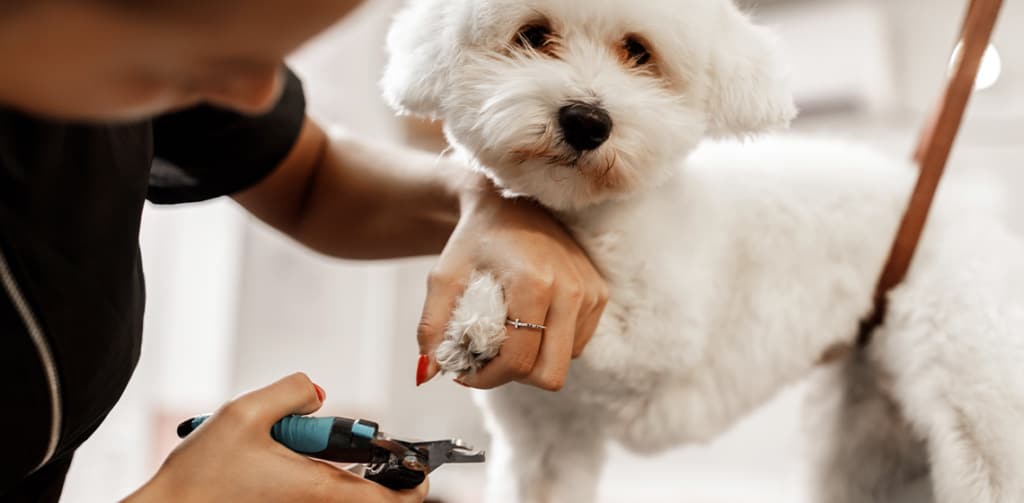Whether you’re a pet parent to a German Shepherd or a Yorkshire Terrier, chances are you’ll have to have their nails trimmed at some point. After all, no one wants to be covered in scratches from their canine companion’s long claws, and no pet parent wants their dog to get an ingrown claw either. So, how do you know if your dog needs their nails clipped? And how do you cut your dog’s nails at home?
Table of Contents
Why do dogs need their nails cut?
Dogs need their nails cut regularly because if they grow too long, it can lead to other problems. For instance, long nails can curl around and grow into the skin or footpad, causing pain and infections. When nails grow too long, they can also cause your dog to walk abnormally, placing weight through parts of their feet they wouldn’t normally. This can lead to muscular pain and stiffness and worsen health conditions like arthritis. You can find out more about arthritis and other causes of limping here.
If dogs nails grow too long, it can lead to other problems.
How do you cut a dog’s nails?
It’s not always easy to clip your canine companion’s claws, but here are some tips to help you do it safely:
Be prepared
Before you start, it’s best to get everything you need ready. Make sure you have a set of appropriately sized dog nail clippers and some treats as a reward. You might also want to get a clean towel or gauze, just in case you accidentally cause a nail to bleed.
Get help
Ideally, clipping nails is a two-person job. It’s much easier and safer if one person gently restrains the dog, leaving the other free to focus on the nails. After all, a moving target can make things tricky! So, it’s best to ask a family member or friend to help you if you can.
Take it slow
If your dog doesn’t like having their nails cut, or if you’ve never cut their nails before, they’ll probably be wary, to begin with. Approach them slowly and quietly and spend some time giving them attention and love to reassure and calm them. Once they are more at ease, start by cutting just one claw and see how they react. If they are distressed, give them a break and try again later or another day.
Before you start, it’s best to get everything you need ready.
Celebrate small victories
It might feel frustrating having to cut your dog’s nails so slowly and give them regular breaks. However, it’s best to stay positive, even if you’ve only managed to cut a couple of nails this time. Over time, your furry friend will become more confident and see that having their nails trimmed isn’t so bad after all.
Give a reward
To keep up the positive vibes, give them a treat and plenty of verbal praise when your pooch sits still and allows you to cut their nails. This positive reinforcement is far more likely to improve behavior than punishing them or shouting at them.
Don’t panic
Accidentally cutting the quick of the nail is easily done. If you do make the nail bleed, apply some firm pressure for five to ten minutes. If the bleeding persists after this time, you should contact your veterinarian.
How do you cut a dog’s nails for beginners?
The trick with cutting a dog’s nails is to know where to cut to avoid the quick. In white or light-colored nails, you can see the quick as a pale pink section, similar to the color of our nails where they are attached to the skin. However, dark or black nails are not so easy because you can’t see the quick. In this case, there are two tips that might help. Firstly, try to look at the shape of the nail from the side. If there is a visible ‘hook’ at the tip of the nail, this is the overgrown nail. But whenever you clip a black nail, you can test whether you’re about to cut the quick by applying some pressure with the clippers before you cut. If your dog reacts or tries to pull their foot away, you’re likely a little close to the quick.
When to see a vet
If your dog’s claws are getting long and, despite your efforts, you can’t clip them, it’s best to speak to a veterinarian or a groomer before they start to cause a problem. If you notice that your dog is limping or licking their nails, they might have ripped a nail, or their claw may have grown into their pad. This is particularly common with dewclaws, and you can find out more information here. These conditions are really painful and often require antibiotics and pain relief. So, it’s best to get their nails cut before these problems develop.
If your dog’s claws are getting long and, despite your efforts, you can’t clip them, it’s best to speak to a veterinarian or a groomer before they start to cause a problem.
Summary
Cutting your dog’s nails for the first time can be nerve-wracking and even frustrating. Try to stay calm because your furry family member might pick up on your nerves and get more anxious. If you take it slowly and give lots of praise and rewards, your dog will hopefully learn to love, or at least tolerate, a manicure!
FAQ
If you follow the tips and advice above, you should be able to cut your dog’s nails at home safely. However, if you’re struggling, ask a groomer or veterinarian for help.
If you can see the quick through your dog’s nails, you should aim to cut just below that to avoid causing bleeding. If the nails are black, it’s a little more difficult because you can’t see the quick. It’s best to err on the side of caution, taking just a little off the nail at a time.
It’s not easy to cut black nails, but if you apply some pressure with the clippers before you cut, you can check whether your dog reacts. If they seem uncomfortable, you’re likely too close to the quick and should cut less off the nail.

Dr. Hannah Godfrey MRCVS graduated from the Royal Veterinary College in 2011. Although she initially worked in mixed practice treating all species, she found a love for small animal work and has worked exclusively with dogs and cats since 2014. She lives in Wales with her partner, son, and two cats (named Poppy and Ashton Kutcher), and writes comedy fiction in her spare time.








